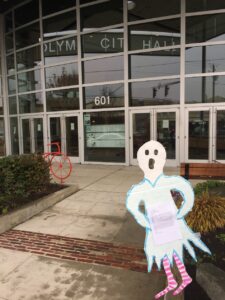Stories, science and strategies
 In the first two weeks of December, around 700 worker health advocates made their way (online) to the 10th annual COSHCON—Council on Occupational Safety and Health Conference.
In the first two weeks of December, around 700 worker health advocates made their way (online) to the 10th annual COSHCON—Council on Occupational Safety and Health Conference.
The fully bilingual conference was built on the long struggle—going back centuries –for the right to work without sacrificing life and limb. As the old song goes “we just come to work here, we don’t come to die.”
If you are facing an immediate danger at work
CALL 1-800-321-OSHA
Over the course of six days, a broad range of workers and their allies shared stories about the conditions that make going to work a risky affair. Despite the short flurry of support (it seems so long ago) for health care workers and others on the frontlines of the COVID-calamity, many of the folks who help hold our health and the economy together feel abandoned and used up.
On the climate crisis front, many workers are sent into flood-and-fire—to harvest the food for our families, to fight the infernos of the West, or to do dangerous storm cleanup throughout the South and Midwest. Many of these people don’t have the benefit of unions or protective legislation or functioning public agencies. They’re just out there doing the work.
Joining the COSH gathering can be an antidote to the isolation that accompanies workplace risk and the vulnerability of speaking out on behalf of other workers. As one man said after having been actively involved in discussions with allies, “we don’t feel alone.”
Linking experience, legal strategies, science and movement building
COSH is a network of unions, public health providers, health researchers, legal rights advocates and members of movements for justice around race/class/gender, climate, COVID and economic rights.
Sponsors and participants in the conference included major unions along with groups like the Coalition of Black Trade Unionists, the National Day Laborers Organizing Network and the Mississippi Workers Center for Human Rights. Environmentalists such as Public Citizen and the Union of Concerned Scientists are also strategic partners.
These groups are increasingly joined by emergent worker centers. These are labor/community organizations that support workers who are not yet in a union, and whose organizing efforts assist and strengthen the mainstream labor movement.
Protecting workers has never been just about building legislation and administrative structures. It’s about working in real-time, with clear and present dangers that require creative, bold measures. It’s about connecting with scientists and health care providers who are democratic and committed in their collaboration with workers.
The mission of the COSH network is to support workers by learning from them about the specific health and safety conditions they face, and the efforts they make to protect themselves. The force of these conferences emerges from workers’ reports on what they face daily—in the political patchwork across the country.
Discussions about building safety and health committees, contract negotiations, getting the attention of local and national media—these are key building blocks for protecting lives. Conference members had a promising online meeting with OSHA officials—some of whom are considered strong friends of labor.
The worker safety and health zone is complicated, with a complex matrix of legal and legislated features to figure out… whether you’re in a state OSH system, or your workplace is regulated by OSHA. Whether or not you’re in a union and even then, depending on your contract and whether safety is central to the agreement. How your part of the economy—high-tech vs agriculture for example—fits into the health and safety picture.
The core principles of safety and health organizing were listed by Jaribu Hill, founder and director of the Mississippi Worker Center for Human Rights:
- stay engaged
- always prioritize those who suffer the most
- be respectful of workers’ time
- supporters shouldn’t take up the space
- sustain a strong critical stance against corporate power
- make this basic commitment: “We can’t let trauma paralyze us. We must let trauma mobilize us.”
Campaigns and goals at the national and local level
At COSHCON 2021, heat/climate was a major thread. We might be in the chill-blast of winter now, but we remember the summer’s heat, from fires in British Columbia to evacuated towns in Oregon. At the center of it in terms of risk: outdoor workers, from firefighters to farmworkers. A “Heat 101” workshop examined people’s experience with heat-stress (feeling “head-bumped,” “bear-caught,” experiencing fainting, heat rashes, cramps, and full-scale heat stroke). Exposed workers urgently need information on what to look for, how to care for each other and how to organize for protection—water, shade, rest breaks, diagnostic monitoring. Mapping protections across state lines can feel like a crazy-quilt, with regulations, proposed regulations or no regulations.
Another workshop, “Heat: Policy & Worker Campaigns” explored what operates on behalf of high-risk workers. Although OSHA was launched in 1970, there is to this day no “heat rule.” The movement for nationally enforced and effective protections resulted in a proposal by Public Citizen for a binding heat rule. (The rule and other information are on the Public Citizen site; comments are invited through the end of January.)
At the same time, Public Citizen and its allies are pushing for national legislation—the Asuncion Valdivia Heat Illness and Fatality Prevention Act. Named in honor of one of many farmworkers who have died from heat exposure, the Act would require OSHA to create an effective rule.
Another promising development is a strategic campaign in Washington, Oregon and California to bring together primary care, worker health and environmental protection. This campaign is pushing governors and related agencies of the West Coast states to create a PACT that will coordinate across state lines to lift worker protection to the highest level.
As it is now, a migrant farmworker faces different levels of protection in each state, with confusing and inconsistent practices. Ira Cuello-Martinez (PCUN, Oregon farmworkers) and Mary Jo (Moses Lake Community Health Center) spoke about how movement building in the West emerged from farmworkers telling their stories and clinicians seeing the impacts. This led to a broad-based push on state authorities that bolsters the national coalition, by offering elevated and enforceable measures to protect farmworkers.
Local campaigns are in motion elsewhere. Estaban Wood from WeCount in South Florida spoke about Miami-Dade having “the first in the world” municipal heat officer and the goal of a “municipal heat standard.” In California, Jobs with Justice has mobilized “Farmworkers in Fires” in Sonoma County, focusing on language justice, premium hazard pay and community safety observers.
A panel titled “Climate Justice = Worker Justice”—promoted the foundational principle of “just transition.” Urgently needed moves to address climate change must include workers’ voices as part of the broader movement. Roger Cook, former director of the Western New York COSH in Buffalo, stressed the need for unions to divest from fossil-fuel companies, and for environmentalists to take seriously the development of “climate jobs”—funding green projects, with well-paid and well-trained workers.
A call for persistent action at the local level
A year from now there will be another COSHCON—to help lead the way. But way before that, our role is to look into ideas and resources that can be activated and deployed now.
Go to the COSH network to learn more about what’s going on, to build bridges between labor and related movements for environmental justice.
We don’t have a lot of time.
Lin Nelson is a retired Evergreen teacher and part of the COSH Advisors network, in support of workplace health education and organizing.
Sí se puedeA worker health activist from Central California talked about what it’s like to support farmworkers who are the life-force of the food economy. They’re told that they are “essential”, but they face reprimand or firing if they speak up about their concerns. This summer’s high heat in the West created worker sacrifice-zones, as they returned to the fields again and again to pull in the harvest. In many of California’s agricultural areas, close to 80% of the workers speak Mixtec, with Spanish their second language. “Language justice” has become central to health justice as workers grapple with urgent but inaccessible health alerts about temperature, air quality, signs of heat stress and fire risk. Farmworkers are on the frontlines of risk, especially if they are undocumented. ResourcesNational movement-building:
Regional workers support: connections and actions:
|

Be First to Comment